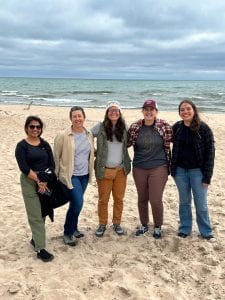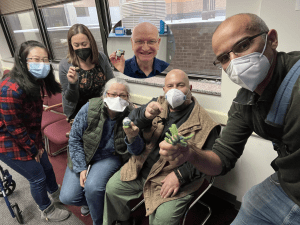We were excited to have Vera visiting Milwaukee for a few days. Seeing her in person instead of on the screen was great. We took a day off to go have some fun, starting off at Kohler-Andrae State Park on a chilly day.
Summer update and recent pubs
We are whooshing through summer already, busy with data generation and analysis, but also taking time for fun and relaxation. Our lab has a lot of different projects going on right now, on lots of different and interesting species. It has been fun and sometimes challenging to think deeply about each project. Such is the nature of conservation I think.
We also have a book chapter and several new lab publications to share (always happy to provide copies):
- Heffelfinger JR, Latch EK (2023) Origin, classification, and distribution. In: Ecology and Management of Black-tailed and Mule Deer of North America (pp. 3-24). CRC Press.
- Hauser SS, Galla SJ, Putnam AS, Steeves TE, Latch EK (2022) Comparing genome-based estimates of relatedness for use in pedigree-based conservation management. Molecular Ecology Resources, 22, 2546-2558.
- Euclide P, Larson W, Bootsma M, Miller L, Scribner K, Stott W, Wilson C, Latch EK (2022) A new GTSeq resource to facilitate multijurisdictional research and management of walleye. Ecology and Evolution, 12, e9591.
- Yi X, Latch EK (2022) Systematics of the New World bats Eptesicus and Histiotus suggest trans-marine dispersal followed by Neotropical cryptic diversification. Molecular Phylogenetics and Evolution, 175, 107582.
- Latch EK, Heffelfinger JR (2022) Genetics informs meaningful intraspecific taxonomy: the black-tailed and mule deer species complex. Animal Production Science, Online Early.
- Yi X, Latch EK (2022) Nuclear phylogeography reveals strong impacts of gene flow in big brown bats. Journal of Biogeography, 49, 1061-1074.
Welcome to Vera!
We are super excited to welcome Vera de Ferran to our group! Vera comes to us with heaps of experience in genomics and bioinformatics, and a love of mammalian evolution and conservation. See Vera’s recent paper on phylogenomics of the world’s otters in Current Biology. Welcome Vera!
IDBC in Croatia!
I was honored to be invited as a plenary speaker at the International Deer Biology Congress in Osijek, Croatia. It was a fantastic meeting – I learned a lot about deer biology, made interesting comparisons about management across species and regions of the world, met some incredible people, and enjoyed seeing a new (to me) part of the world!
https://www.deerbiologycongress.org/
Welcome Billie!
We are super excited to welcome Billie Harrison to the lab! Billie has been working in herp conservation for many years, most notably with the Eastern Massasauga SSP and with the critically endangered Grenada frog. In our lab she will continue her work with the Grenada frog, incorporating genetics to better understand population demography and connectivity. Welcome Billie!
We are recruiting a postdoc!
We are excited to be able to recruit a postdoc to join the lab and work on Hawaiian monk seal conservation genomics! Our flyer advertising the position is below, but please reach out if you have any questions or want to apply!
PDF of advertisement: Postdoc_Conservation genomics Hawaiian monk seal
Text of advertisement:
Postdoctoral position: Conservation genomics of the endangered Hawaiian monk seal
Latch Laboratory, University of Wisconsin-Milwaukee
We seek a highly motivated candidate with a background in population genomics to fill a postdoctoral researcher position. The objective of this project is to develop and validate a robust SNP genotyping panel for consistent and efficient genotyping of Hawaiian monk seals, using genomic data we have generated. The developed panel will then be used to address questions related to inbreeding, parentage, and conservation management. This position is based in the Latch Lab at the University of Wisconsin-Milwaukee (http://www.uwm.edu/~latch), though the successful candidate will work with federal and academic collaborators. The appointment is currently funded for 1 year, with a competitive salary of $55,000 plus full benefits.
Responsibilities:
- Bioinformatic analysis and interpretation of genome sequence data
- Simulations to support bioinformatic analyses
- Laboratory work to generate additional whole genome resequencing data as needed
- Preparing manuscripts as lead author, assisting with preparation of reports for relevant stakeholders, and contributing to grant proposals to support novel projects
- Coordination and communication with research team and collaborators
Qualifications:
- PhD in population genetics, molecular ecology, bioinformatics, or a related field
- Proficiency in R programming language
- Experience working with high-throughput sequencing data
- Demonstrated record of research productivity, especially through a strong publication record
- Excellent communication skills
- Strong organizational skills
- Interest in conservation biology, population genetics, and/or mammalian genomics
To apply, send an email to Dr. Emily Latch (latch@uwm.edu) describing your previous experience and fit to the position. Attach a CV with contact details for 3 references. Review of applications will begin in July 2022 and considered on a rolling basis until the position is filled. The position is available immediately, with a flexible start date no later than January 2023. Questions can be directed to Dr. Emily Latch.
Spring update and new pubs
Another successful semester in the books! Perhaps the brightest spot was that Ling defended her PhD with flying colors, and wow’ed everyone with her extraordinary work on bat systematics and phylogeography.
We are also excited to welcome a new PhD student into the lab this fall – Billie Harrison has been working with the endangered Grenada frog for several years, and we are looking forward to incorporating some genetic work into her conservation assessments!
We also have had a few new publications come out over these first few months of 2022:
Cook RM, Suttner B, Giglio RM, Haines ML, Latch EK (2022) Selection and demography drive range-wide patterns of MHC-DRB variation in mule deer. BMC Ecology and Evolution, 22, 1-7. https://doi.org/10.1186/s12862-022-01998-8
Yi X, Latch EK (2022) Nonrandom missing data can bias Principal Component Analysis inference of population genetic structure. Molecular Ecology Resources, 22, 602-611. https://doi.org/10.1111/1755-0998.13498
Galla SJ, Brown L, Couch‐Lewis Y, Cubrinovska I, Eason D, Gooley RM, Hamilton JA, Heath JA, Hauser SS, Latch EK, Matocq MD (2022) The relevance of pedigrees in the conservation genomics era. Molecular Ecology, 31, 41-54. https://doi.org/10.1111/mec.16192
Congrats to Ling!
Ling successfully defended her PhD! Dr. Yi will be headed to the lab of Juha Merilä to study adaptation. A perfect next step to build on her incredible work studying the systematics and biogeography of Eptesicus and Histiotus bats. CongratsLing!

Welcome to Anaïs!
We are excited to welcome Anaïs (Anya) Tallon to the frozen tundra that is Milwaukee in January! Anya will be a postdoctoral fellow in our lab, working on the development of a GT-seq panel for white-tailed deer to aid in the management of chronic wasting disease (CWD). Welcome Anya!
Recent pubs
We’ve had a busy fall and early winter with several papers coming out. Congrats to all!
Yi X, Latch EK (2022) Nonrandom missing data can bias PCA inference of population genetic structure. Molecular Ecology Resources, 22, 602-611.
Galla SJ, Brown L, Couch‐Lewis Y, Cubrinovska I, Eason D, Gooley RM, Hamilton JA, Heath JA, Hauser SS, Latch EK, Matocq MD (2022). The relevance of pedigrees in the conservation genomics era. Molecular Ecology Resources, 31, 41-54.
Hardy BM, Pope KL, Latch EK (2021) Genomic signatures of demographic declines in an imperiled amphibian inform conservation action. Animal Conservation, 24, 946-958.
